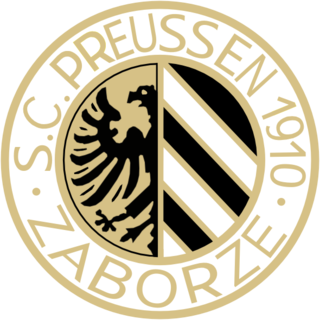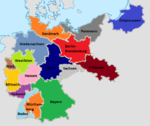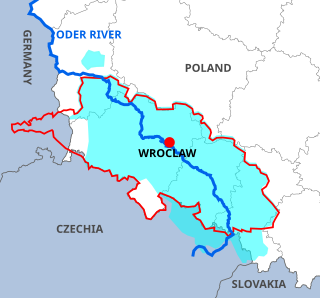
The Province of Upper Silesia was a province of the Free State of Prussia from 1919 to 1945. It comprised much of the region of Upper Silesia and was eventually divided into two government regions (Regierungsbezirke) called Kattowitz (1939-1945), and Oppeln (1819-1945). The provincial capital was Oppeln (1919–1938) and Kattowitz (1941–1945), while other major towns included Beuthen, Gleiwitz, Hindenburg O.S., Neiße, Ratibor and Auschwitz, added in 1941. Between 1938 and 1941 it was reunited with Lower Silesia as the Province of Silesia.
AKS Chorzów is a sports club in based in Chorzów, Poland. It is one of the earliest sports organizations in Upper Silesia and is still well-known nationally for its football and handball teams. The club also made its mark on the international stage: Halina Richter-Górecka was part of the gold-medal winning women's 100m relay team at the 1964 Tokyo Olympic Games; tennis player Danuta Wieczorek appeared at Wimbledon as a junior.

1. FC Kattowitz was an ethnically German football club playing in what was Kattowitz, Silesia Province in Germany and was active during the inter-war period and World War II when the two countries struggled over control of the region. Established in 1905, the original club disappeared in 1945; a modern-day Polish club using the name 1. FC Katowice was formed in 2007.

Vorwärts-Rasensport Gleiwitz was a German association football club from the city of Gleiwitz, Upper Silesia, today Gliwice, Poland.

A Gauliga was the highest level of play in German football from 1933 to 1945. The leagues were introduced in 1933, after the Nazi takeover of power by the Sports office of the Third Reich.

The Gauliga Ostpreußen was the highest football league in the Prussian province of East Prussia and the Free City of Danzig from 1933 to 1945. Shortly after the formation of the league, the Nazis reorganised the administrative regions in Germany, and the GauEast Prussia the Prussian province. Danzig however did not became part of this Gau, being integrated in the Gau Danzig-West Prussia in 1939 instead.

The Gauliga Nordmark was the highest football league in the Prussian Province of Schleswig-Holstein and the German states of Hamburg, Lübeck, Mecklenburg-Schwerin, Mecklenburg-Strelitz and parts of Oldenburg from 1933 to 1945. Shortly after the formation of the league, the Nazis reorganised the administrative regions in Germany, and the GaueHamburg, Mecklenburg and Schleswig-Holstein replaced the Prussian province and the German states in this northern region of Germany.

The Gauliga Wartheland was the highest football league in GauWartheland from 1941 to 1945. The Gau was made up from the former Polish Voivodeship of Poznań and parts of Warsaw Voivodeship and Łódź Voivodeship which had been occupied by Nazi Germany in 1939 and incorporated into the Third Reich. The league and the region are named after the local river Warthe (Polish:Warta), and not after the Prussian province Posen, which it had been from 1848 to 1918.

The Gauliga Generalgouvernement was the highest football league in Polish areas annexed by Nazi Germany after 1939, which were not incooperated into any of the Gaue, the so-called General Government. The name Gauliga is somewhat misleading in this case as the region was not part of the Gau system. The league existed from 1941 to 1945.

SC Diana Kattowitz was an ethnically German association football club playing in what was Kattowitz, Upper Silesia in Germany during the inter-war period. Established 13 February 1905, it was one of a small number of clubs that made up the Kattowitzer Ballspiel-Verband alongside Preussen Kattowitz and Germania Kattowitz. With FC 1903 Ratibor, these clubs formed the Upper Silesian division of the Southeast German Football Federation in 1906.

Preußen Hindenburg was a German association football club from the city of Zaborze, Upper Silesia in Germany.
East Upper Silesia is a term denoting the easternmost extremity of Silesia, the eastern part of the Upper Silesian region around the city of Katowice. The term is used primarily to denote those areas that became part of the Second Polish Republic on 20 June 1922, as a consequence of the post-World War I Treaty of Versailles. Prior to World War II, the Second Polish Republic administered the area as Autonomous Silesian Voivodeship. East Upper Silesia was also known as Polish (Upper) Silesia, and the German (Upper) Silesia was known as West Upper Silesia.

The South Eastern German football championship was the highest association football competition in the Prussian provinces of Silesia, which was divided into the Province of Lower Silesia and the Province of Upper Silesia after 1919, and Posen, which mostly became part of Poland in 1919. The competition was disbanded in 1933.

The 1935–36 Gauliga was the third season of the Gauliga, the first tier of the football league system in Germany from 1933 to 1945.

The 1938–39 Gauliga was the sixth season of the Gauliga, the first tier of the football league system in Germany from 1933 to 1945. It was the last completed season before the Second World War.

The 1939–40 Gauliga was the seventh season of the Gauliga, the first tier of the football league system in Germany from 1933 to 1945. It was the first season held during the Second World War.

The 1940–41 Gauliga was the eighth season of the Gauliga, the first tier of the football league system in Germany from 1933 to 1945. It was the second season of the league held during the Second World War.

The 1941–42 Gauliga was the ninth season of the Gauliga, the first tier of the football league system in Germany from 1933 to 1945. It was the third season of the league held during the Second World War.

The Gau Upper Silesia was an administrative division of Nazi Germany from 1941 to 1945 in the Upper Silesia part of the Prussian Province of Silesia. The Gau was created when the Gau Silesia was split into Upper Silesia and Lower Silesia in 1941. The Gau included territory annexed by Nazi Germany after the German invasion of Poland.

The Gau Silesia was an administrative division of Nazi Germany from 1933 to 1941 in the Prussian Province of Silesia. From 1926 to 1933, it was the regional subdivision of the Nazi Party for these area. The Gau was split into Lower Silesia and Upper Silesia in 1941. The majority of the former Gau became part of Poland after the Second World War, with small parts in the far west becoming part of the future East Germany.

















